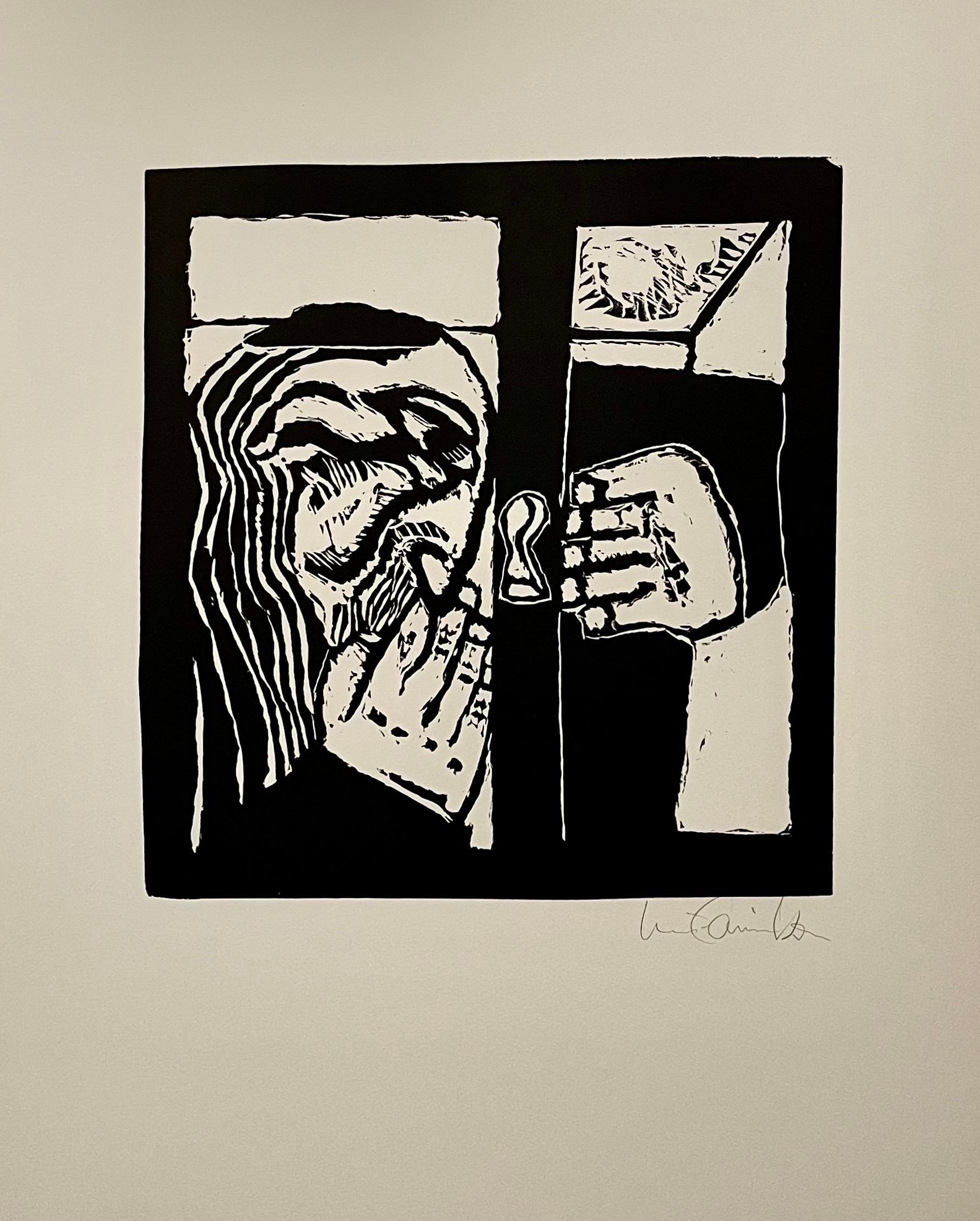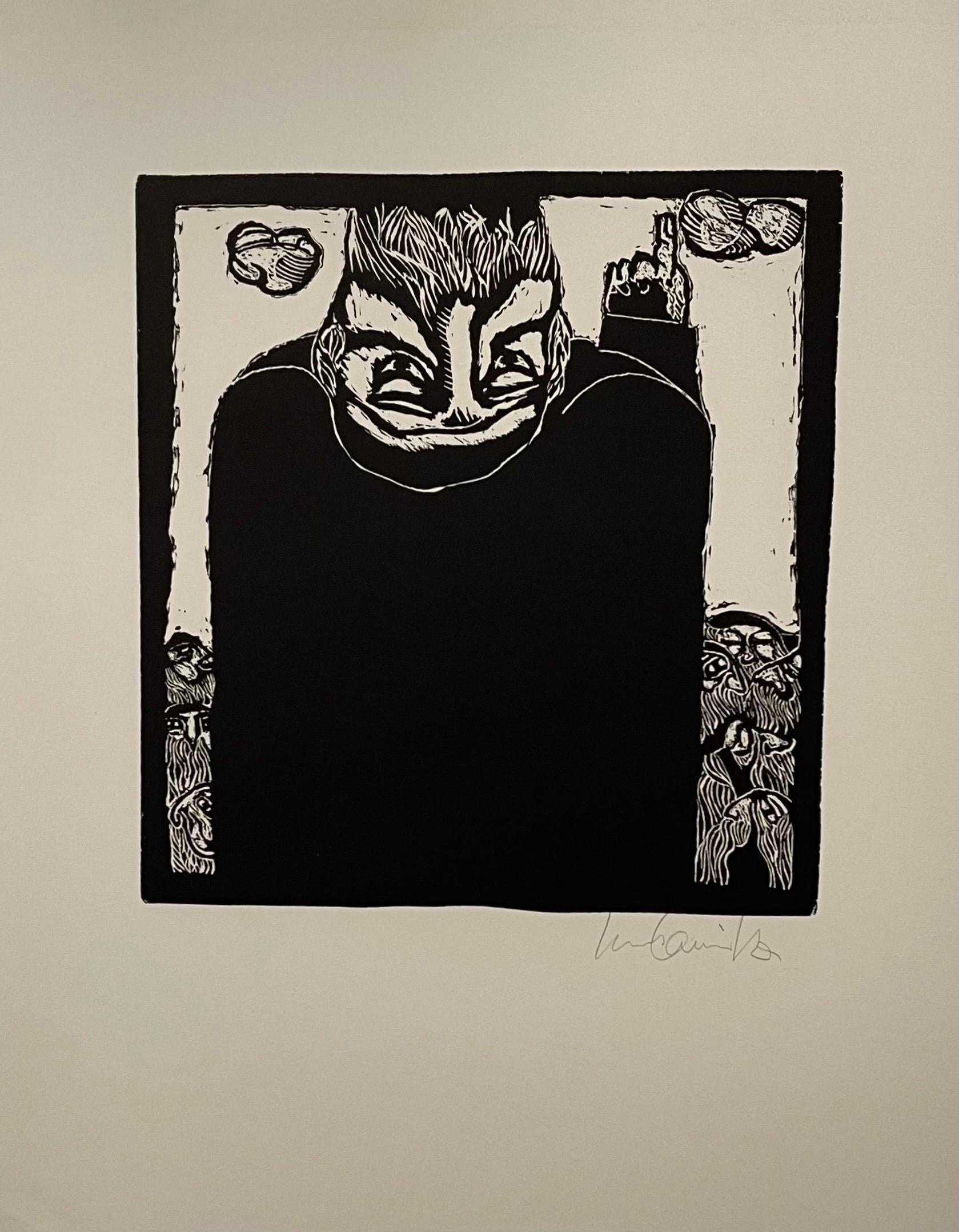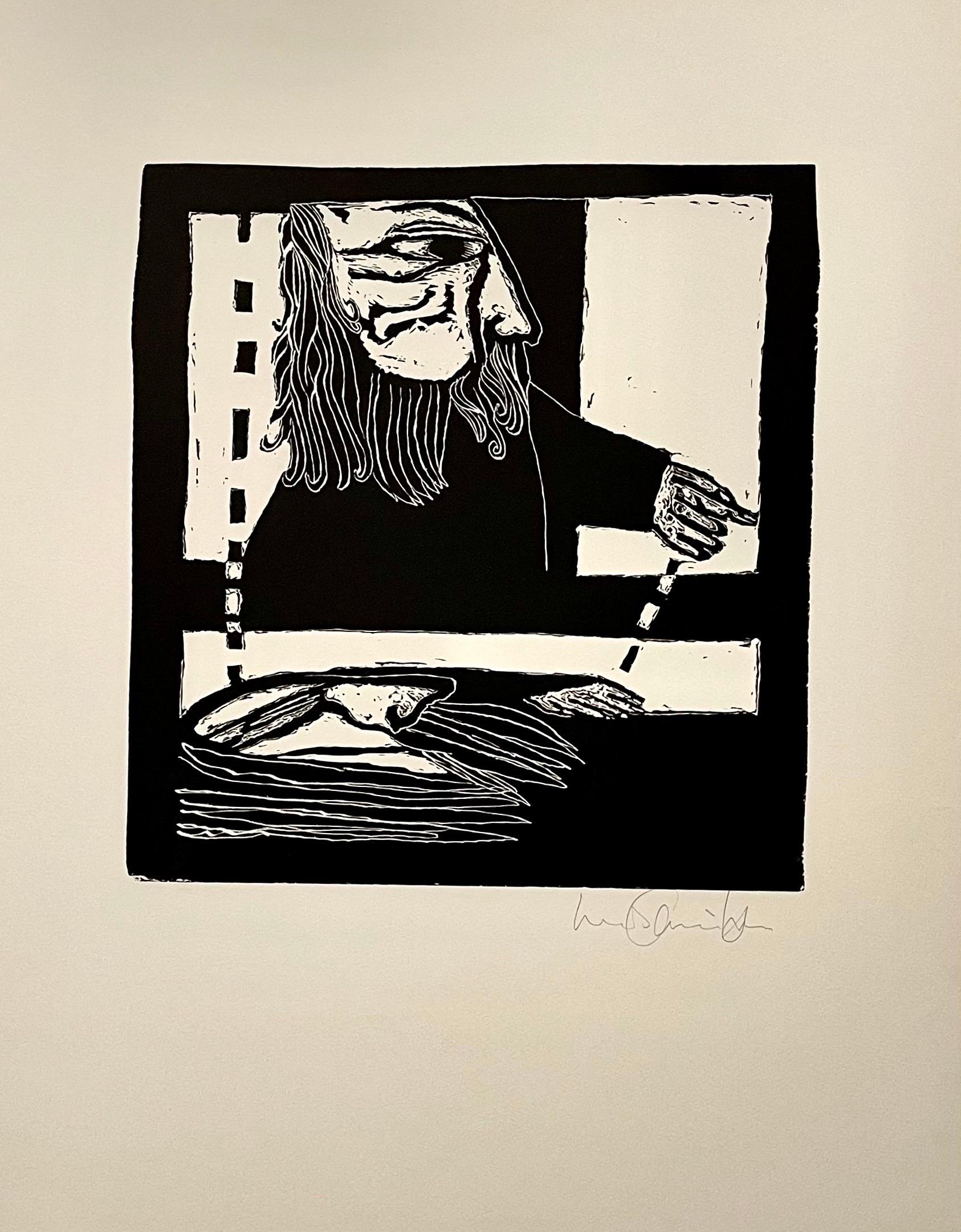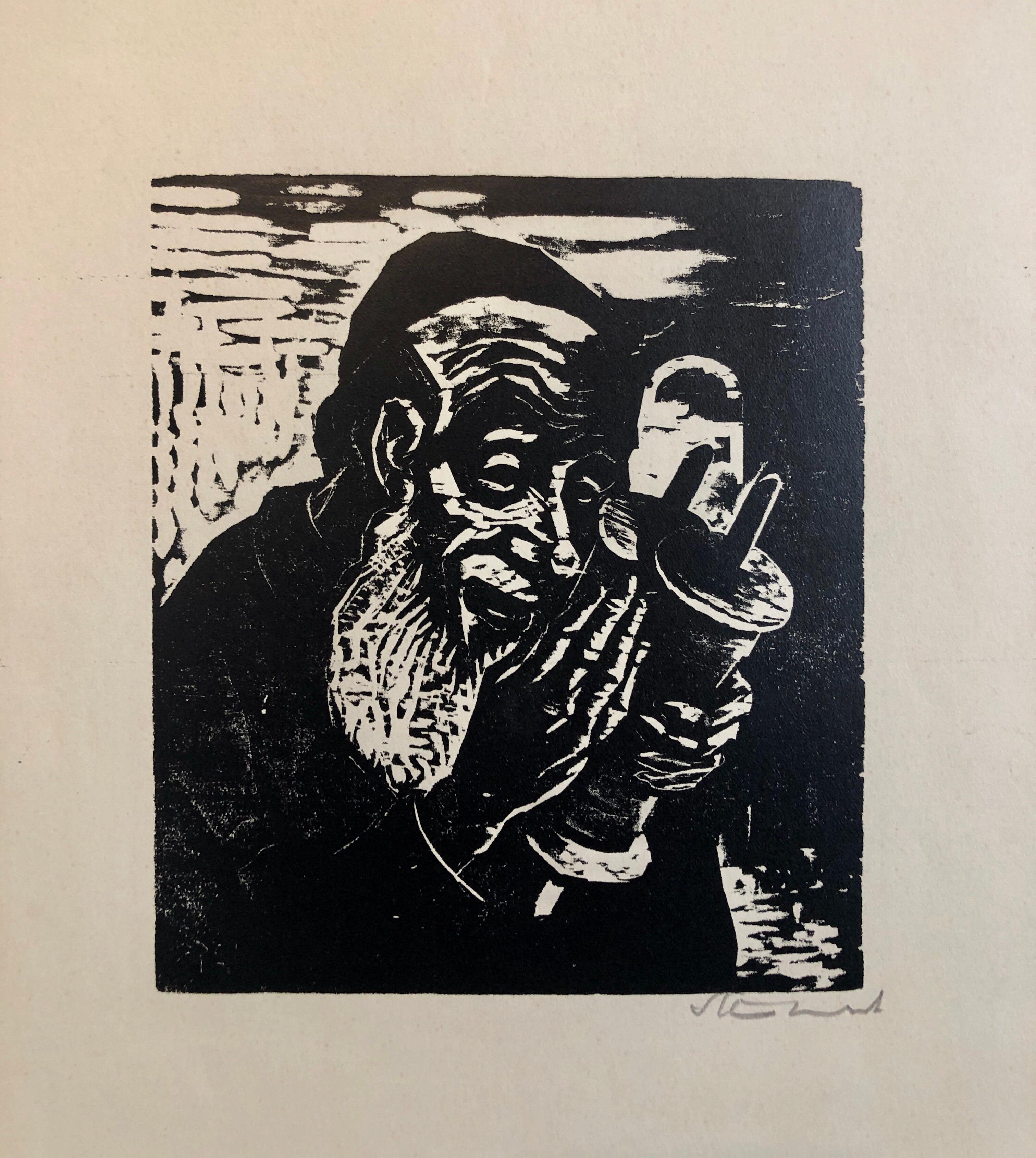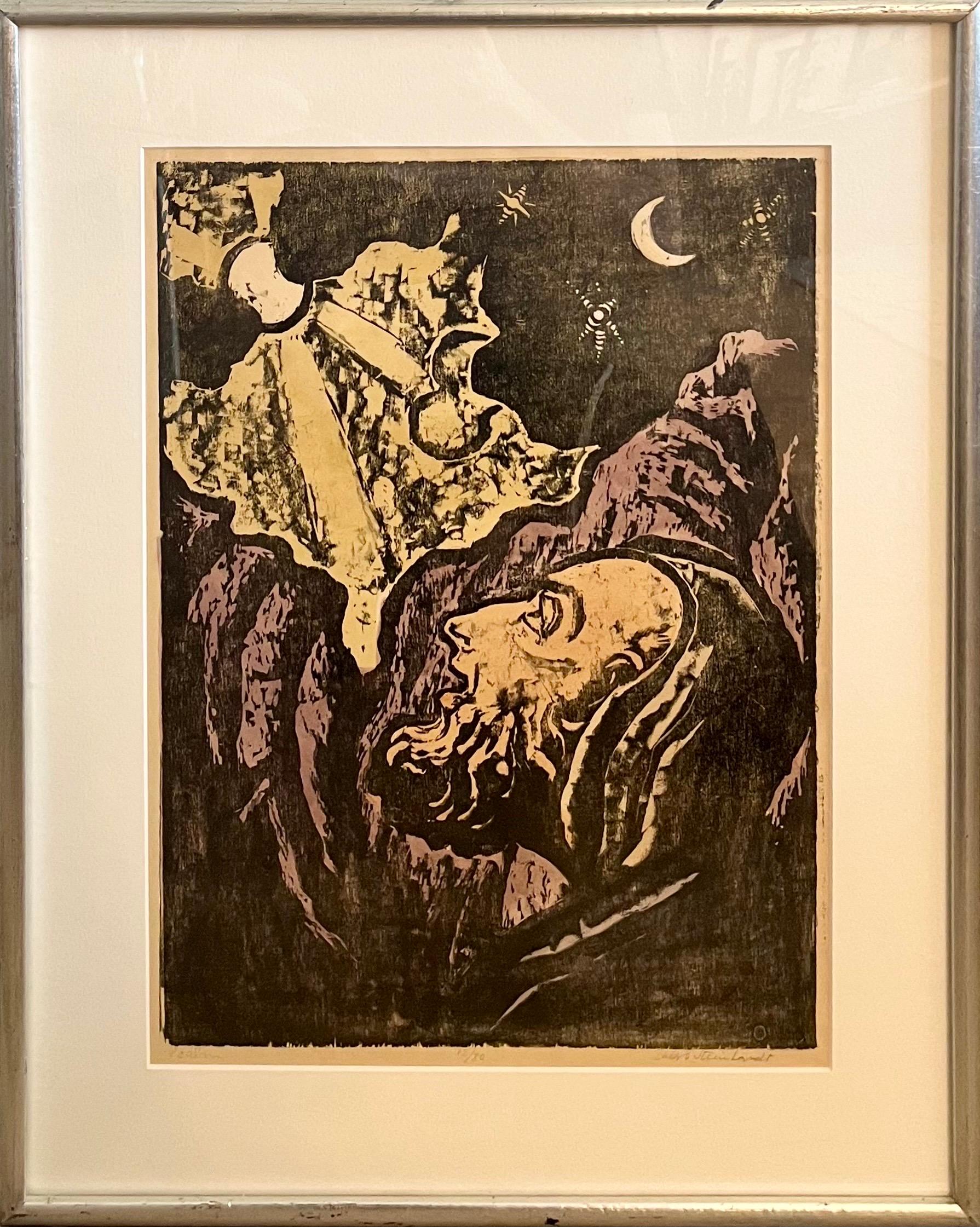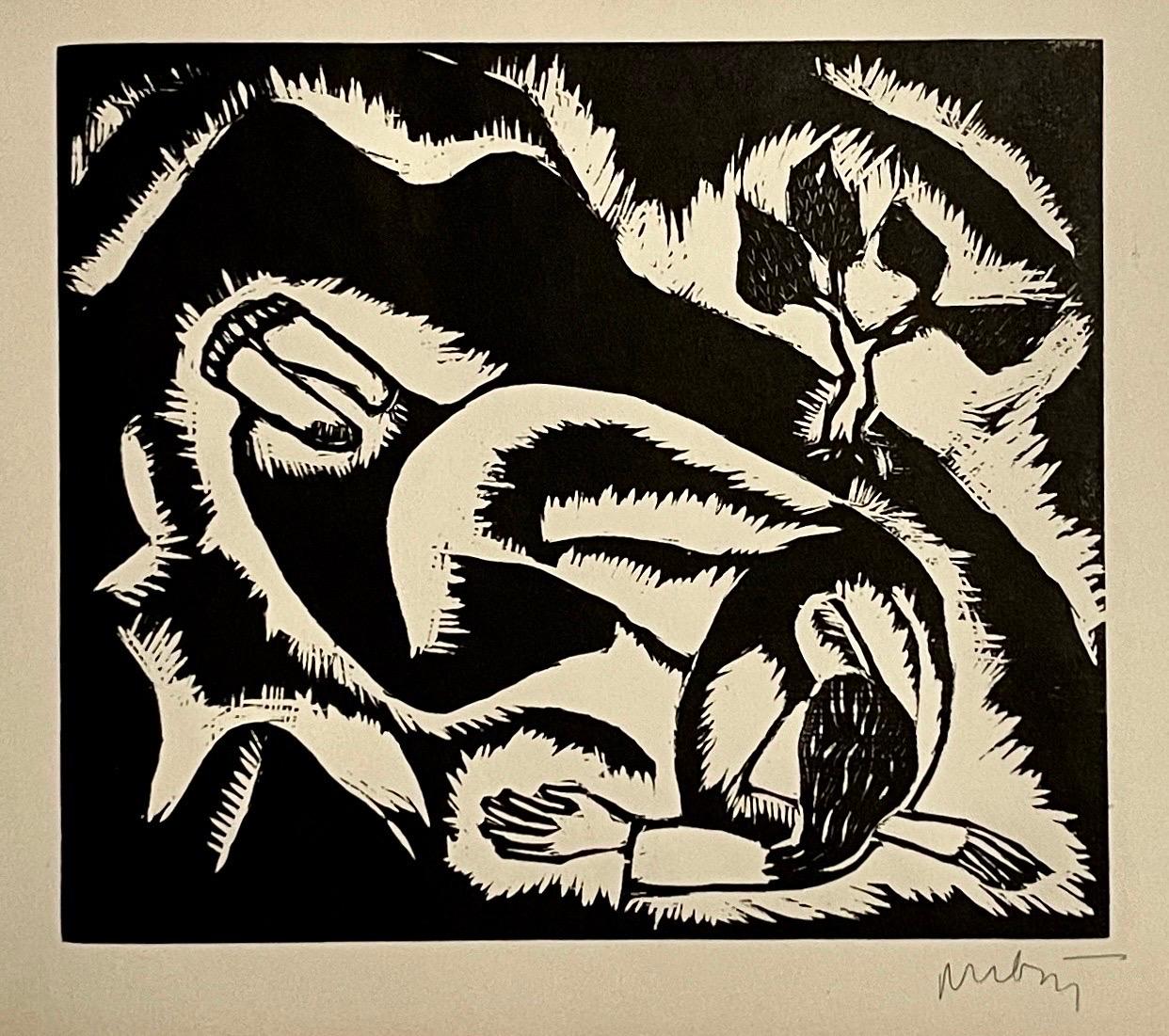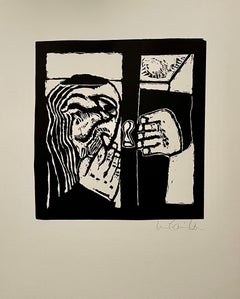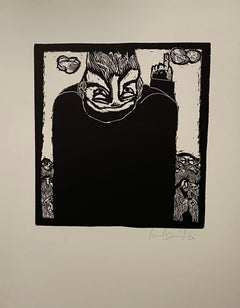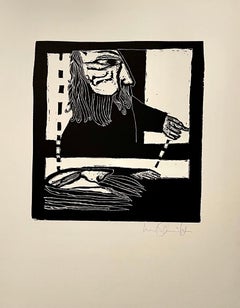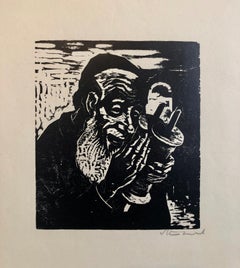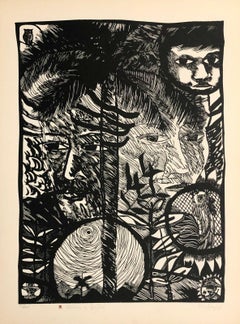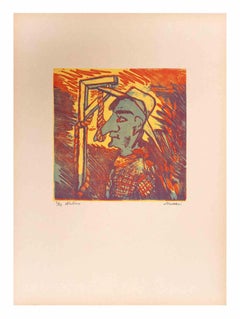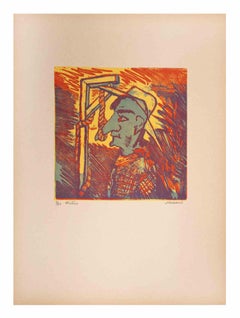Items Similar to Latin American Judaica Conceptual Chassidic Art Modern Woodcut Luis Camnitzer
Want more images or videos?
Request additional images or videos from the seller
1 of 11
Luis CamnitzerLatin American Judaica Conceptual Chassidic Art Modern Woodcut Luis Camnitzer1970
1970
$1,100
£839.94
€956.30
CA$1,544.57
A$1,688.52
CHF 893.30
MX$20,205.87
NOK 11,366.01
SEK 10,404.43
DKK 7,142.98
About the Item
Luis Camnitzer and Martin Buber (1878-1965),
New York: JMB Publishers Ltd, 1970.
Printed at The New York Graphic Workshop.
Hand signed on Arches paper. (Edition 24/100, numbered on Justification page)
Woodblock prints based on folktales from the Hasidic Jewish tradition in Eastern Europe, selected by Camnitzer from the early masters section of Buber’s Die chassidischen Bücher as translated by Olga Marx. German Expressionist style Jewish woodcuts by Camnitzer titled: The Tap at the Window; The Helpful Mountain; The Deaf Man; How We Should Learn; Failure; Blessing of the Moon; To Say Torah and To Be Torah; The Mountain; The Bird Nest; and The Strong Thief. They feature the figure of the Rebbe or Rabbi done in a poignant yet humorous style.
Luis Camnitzer (born November 6, 1937) is a German-born Uruguayan artist, curator, art critic, and academic who was at the forefront of 1960s Conceptual Art. Camnitzer works primarily in sculpture, printmaking, and installation, exploring topics such as repression, institutional critique, and social justice. For over five decades, his practice has explored the psychological and political dimensions of language.
Luis Camnitzer was born in Lübeck, Germany in 1937 and moved to Montevideo, Uruguay in 1939. In 1953, he studied at the University of Montevideo's Escuela Nacional de Bellas Artes, where he concentrated on sculpture and architecture. In 1957, Camnitzer received a grant from the German government to study at Akademie der Bildenden Künste München At the Akademie, Camnitzer was mentored by sculptor Heinrich Kirchner.
In 1960 Camnitzer held his first solo exhibition at the Centro de Artes y Letras Montevideo and the following year began teaching at the Escuela Nacional de Bellas Artes. Camnitzer subsequently moved from Montevideo, Uruguay to New York City in 1964. In New York, he and fellow artists Argentine Liliana Porter and Venezuelan Guillermo Castillo (1941–1999). founded the New York Graphic Workshop (1964–1970), a studio focused on redefining the medium of printmaking and dedicated to reviving its importance as a contemporary art form. Beginning in the late 1960s and evolving into the 1970s and 80s, his practice also expanded to examine socio-political issues, including the oppression and cruelty of military dictatorships in Latin America. Camnitzer produced one of his most important works, the Uruguayan Torture Series (1983–84). This series of photo-etchings emphasizes the artist's interest in combining socio-political critique with the psychological implications of text and images. Since the 1980s Camnitzer has produced installations and site-specific works, such as A Museum is a School (2009–present), in addition to his continuing practice in printmaking. He has exhibited at MoMA in many exhibitions and has been included in print shows with
Thomas Bayrle, Mel Bochner, Louise Bourgeois, Marcel Broodthaers, Alberto Burri, Vija Celmins, Jean Fautrier, Jasper Johns, Käthe Kollwitz, Glenn Ligon, Henri Matisse, Pablo Picasso and Andy Warhol. In 2018 a retrospective exhibition, Luis Camnitzer: Hospicio Para Utopias Fallidas, opened at Museo Reina Sofia. Since the 1960s, Camnitzer has focused on political subjects including identity, language, freedom, ethics, and historical tragedy. Camnitzer is a Uruguayan citizen. He lives and works in Great Neck, New York and taught at SUNY Old Westbury, where he is currently professor emeritus. Camnitzer has written several books, including New Art of Cuba (1994) and Conceptualism in Latin American Art: Didactics of Liberation (2007). He is represented by Alexander Gray Associates.
Representation in public collections
ARCO Corporation, New York, NY
Biblioteca Communale, Milan, Italy
Bibliothèque Nationale, Paris, France
Blanton Museum of Art, University of Texas, Austin, TX
Cabinet of Drawings and Prints of the Uffizzi, Florence, Italy
Casa de las Américas, Havana, Cuba
Centro Galego de Arte Contemporánea, Santiago de Compostela, Spain
Centro Wifredo Lam, Havana, Cuba
Colby College Museum of Art, Waterville, ME
Colección Patrica Phelps de Cisneros, Caracas, Venezuela/New York, NY
Daros-Latinamerica, Zürich, Switzerland
Fonds Régional d’Art Contemporain de Lorraine, France
Israel Museum, Jerusalem, Israel
J. Paul Getty Museum, Los Angeles, CA
The Jewish Museum, New York, NY
Library of Jerusalem, Israel
Malmö Stad, Sweden
Metropolitan Museum of Art, New York, NY
Museo de Arte Contemporáneo de Castilla y León, León, Spain
Museo de Arte Latinoamericano de Buenos Aires, Argentina
Museo de Arte Moderno, Bogotá, Colombia
Museo de Arte Moderno, Buenos Aires, Argentina
Museo de Arte Moderno, Cartagena, Colombia
Museo de Arte y Diseño Contemporáneo, San José, Costa Rica
Museo de Artes Plásticas, Montevideo, Uruguay
Museo de Bellas Artes, Caracas, Venezuela
Museo de Gráfica y Dibujo Latinoamericano, Roldanillo, Colombia
El Museo del Barrio, New York, NY
Museo del Grabado, Buenos Aires, Argentina
Museo La Tertulia, Cali, Colombia
Museo Nacional Centro de Arte Reina Sofía, Madrid, Spain
Museo Nacional de Artes Visuales, Montevideo, Uruguay
Museo Nacional de Bellas Artes, Havana, Cuba
Museo Nacional de Bellas Artes, Santiago, Chile
Museo Universitario de Arte Contemporáneo, Mexico City, Mexico
Museu de Arte Contemporânea da Universidad de São Paulo, Brazil
Museum Lodz, Łódź, Poland
Museum of Contemporary Art, Skopje, Republic of Macedonia
Museum of Contemporary Graphic Art, Fredrikstad, Norway
Museum of Fine Arts, Houston, TX
The Museum of Modern Art, New York, NY
Museum Wiesbaden, Germany
National Museum of Modern Art, Baghdad, Iraq
The New York Public Library, New York, NY
Queens Museum, New York, NY
São Paulo Museum of Art, Brazil
Smithsonian American Art Museum, Washington, DC
Snite Museum, Notre Dame University, South Bend, IN
Solomon R. Guggenheim Museum, New York
Tate Modern, London, United Kingdom
Walker Art Center, Minneapolis, MN
Whitney Museum of American Art, New York, NY
Yeshiva University, New York, NY
Awards and recognition
2014 Premio Anual de Literature 2014, Ensayo de Arte, Ministry of Education and Culture, Uruguay
2012 United States Artists Ford Fellow, Visual Arts John Jones Art on Paper Award, Art Dubai: Skowhegan Medal for Conceptual & Interdisciplinary Practices
2011 Frank Jewett Mather Award, College Art Association
2002 Konex Mercosur Award for Uruguay
1998 Latin American Art Critic of the Year Award, Argentine Association of Art Critics
1996 First Prize, ES96, Tijuana Salón Internacional de Estandartes
1991 Art Matters Foundation
1982 Guggenheim Fellowship for Visual Art
1978 Creative Arts Program Services for Sculpture
1974 Prize, British International Print Biennial
1970 Prize, Biennial de San Juan del Grabado Latinoamericano, San Juan, Puerto Rico
1968 Purchase Prize, Museum of Trenton, New Jersey
1965 Memorial Foundation for Jewish Culture
1961 Guggenheim Fellowship for Creative Printmaking
- Creator:Luis Camnitzer (1937, German, Uruguayan)
- Creation Year:1970
- Dimensions:Height: 25.5 in (64.77 cm)Width: 20.5 in (52.07 cm)
- Medium:
- Movement & Style:
- Period:
- Condition:
- Gallery Location:Surfside, FL
- Reference Number:1stDibs: LU38211924472
About the Seller
4.9
Platinum Seller
Premium sellers with a 4.7+ rating and 24-hour response times
Established in 1995
1stDibs seller since 2014
1,846 sales on 1stDibs
Typical response time: 1 hour
- ShippingRetrieving quote...Shipping from: Surfside, FL
- Return Policy
More From This Seller
View AllLatin American Judaica Conceptual Chassidic Art Modern Woodcut Luis Camnitzer
By Luis Camnitzer
Located in Surfside, FL
Luis Camnitzer and Martin Buber (1878-1965),
New York: JMB Publishers Ltd, 1970.
Printed at The New York Graphic Workshop.
Hand signed on Arches paper. (Edition 24/100, numbered on Justification page)
Woodblock prints based on folktales from the Hasidic Jewish tradition in Eastern Europe, selected by Camnitzer from the early masters section of Buber’s Die chassidischen Bücher as translated by Olga Marx. German Expressionist style Jewish woodcuts...
Category
1970s Expressionist Figurative Prints
Materials
Woodcut
Latin American Judaica Conceptual Chassidic Art Modern Woodcut Luis Camnitzer
By Luis Camnitzer
Located in Surfside, FL
Luis Camnitzer and Martin Buber (1878-1965),
New York: JMB Publishers Ltd, 1970.
Printed at The New York Graphic Workshop.
Hand signed on Arches paper. (Edition 24/100, numbered on Justification page)
Woodblock prints based on folktales from the Hasidic Jewish tradition in Eastern Europe, selected by Camnitzer from the early masters section of Buber’s Die chassidischen Bücher as translated by Olga Marx. German Expressionist style Jewish woodcuts...
Category
1970s Expressionist Figurative Prints
Materials
Woodcut
Latin American Judaica Conceptual Chassidic Art Modern Woodcut Luis Camnitzer
By Luis Camnitzer
Located in Surfside, FL
Luis Camnitzer and Martin Buber (1878-1965),
New York: JMB Publishers Ltd, 1970.
Printed at The New York Graphic Workshop.
Hand signed on Arches paper. (Edition 24/100, numbered on Justification page)
Woodblock prints based on folktales from the Hasidic Jewish tradition in Eastern Europe, selected by Camnitzer from the early masters section of Buber’s Die chassidischen Bücher as translated by Olga Marx. German Expressionist style Jewish woodcuts...
Category
1970s Expressionist Figurative Prints
Materials
Woodcut
Jewish Rabbi with Torah German Expressionist Woodcut Israeli Early Bezalel
By Jacob Steinhardt
Located in Surfside, FL
Hand signed in pencil, woodblock print woodcut.
Jacob Steinhardt
1887-1968
Steinhardt, Jakob, Painter and Woodcut Artist. b. 1887, Yaacov Steinhardt was born in the then remote, largely Polish town of Zerkow in the Posen District of Germany. (poland/german) Immigrated 1933. Studies: 1906 School of Art, 1906 Studied in Berlin Arts and Crafts School. Berlin; 1907 painting...
Category
20th Century Expressionist Figurative Prints
Materials
Woodcut
Jewish Rabbi Looking Heavenward German Expressionist Woodcut Israeli "Psalm"
By Jacob Steinhardt
Located in Surfside, FL
Jacob Steinhardt, 1887-1968
Hand signed in pencil, woodblock print woodcut.
Frame: 22.5" x 18"
Image: 16.75" X 12.5"
"Psalm"
12/30
Jakob Steinhardt, Painter and Woodcut Artist. b. 1887, Yaacov Steinhardt was born in the then remote, largely Polish town of Zerkow in the Posen District of Germany. (poland/german) Immigrated 1933. Studies: 1906 School of Art, 1906 Studied in Berlin Arts and Crafts School. Berlin; 1907 painting with Lovis Corinth and engraving and etching with Hermann Struck; advanced studies, 1908-10 Paris, with Henri Matisse and Steinlen; 1911 Italy. Teaching: Bezalel, Jerusalem, 1953-57 Director. 1910 Participated in the “New Sezession”, Berlin. 1912 together with Ludwig Meidner and Janthur he founded the "Pathetiker" group very early in the German expressionist movement. Running afoul of the Nazis, he fled to Tel-Aviv and then Jerusalem in the early 30s, showing in “Der Sturm” Gallery. 1914 Exhibited with ludwig Meidner at first Expressionist Exhibition in Berlin. Worked mainly in woodcuts depicting biblical and other Jewish subjects. 1955-58 International awards for his woodcuts. receives graphic commissions from Fritz Gurlitt. 1922 Marries Minni Gumpert. Active in organizing Secession exhibits. 1925 Trips to Mark Brandenburg and Holy Land. Turns primarily to painting; stops work on etchings and lithographs. 1933 Emigrates to the Palestine. 1934 Moves to Jerusalem and opens an art school; attempts some etchings. 1948 Closes the art school and becomes Chairman of Graphics Department, Bezalel School for Arts and Crafts. 1954-57 Director of Bezalel School for Arts and Crafts. Taken up by J. B. Neumann who became the agent for his etchings. Exhibited Sturm Gallery, Herbst-salon. 1914 Outbreak of World War I; Steinhardt enlists in German army. 1916-18 First on Eastern Front in Poland and Lithuania, then after short training period in Berlin, sent to Macedonia. 1917 Exhibition of Lithuanian drawings at Berlin Secession in Spring. Elected member of the Secession.
He often used wood-cutting techniques that were popular amongst German Expressionists. Steinhardt was driven to express ideas clearly and decisively through art.
Amongst the themes found in his work the prophets of the Bible, such as Jonah, are noticeable. Steinhardt identified deeply with Jonah due to his attempt to run from God's call to duty.
Additionally, the image of beggars was often found in Steinhardt's works and in his artistic presentation of the less fortunate, the artist's love for his fellow man becomes evident.
Moreover, the grotesque was a theme noticeable in Steinhardt's earliest pieces. These were fantastical images; it was unclear whether or not they were human or demon. In the 1950's, Steinhardt returned to these images upon learning of the Holocaust of Europe's Jews. At that time he resided in New York and there, in the shadow of the skyscrapers, Steinhardt's reaction to WWII was expressed through his art.
A Collection of Works by Artists of the Land of IsraelThe Bezalel National Museum, Jerusalem 1940 Artists: Shemi, Menahem Rubin...
Category
20th Century Expressionist Figurative Prints
Materials
Woodcut
Rare 1923 Cubist Reuven Rubin Woodcut Woodblock Print Israeli Hasidic Judaica
By Reuven Rubin
Located in Surfside, FL
This is from the original first edition 1923 printing. there was a much later edition done after these originals.
These are individually hand signed in pencil by artist as issued.
This listing is for the one print. the other documentation is included here for provenance and is not included in this listing.
The various images inspired by the Jewish Mysticism and rabbis and mystics of jerusalem and Kabbalah is holy, dramatic and optimistic Rubin succeeded to evoke the spirit of life in Israel in those early days.
They are done in a modern art style influenced by German Expressionism, particularly, Ernst Barlach, Ernst Ludwig Kirchner, and Franz Marc, as introduced to Israel by Jakob Steinhardt, Hermann Struck and Joseph Budko.
Reuven Rubin 1893 -1974 was a Romanian-born Israeli painter and Israel's first ambassador to Romania.
Rubin Zelicovich (later Reuven Rubin) was born in Galati to a poor Romanian Jewish Hasidic family. He was the eighth of 13 children. In 1912, he left for Ottoman-ruled Palestine to study art at Bezalel Academy of Art and Design in Jerusalem. Finding himself at odds with the artistic views of the Academy's teachers, he left for Paris, France, in 1913 to pursue his studies at the École Nationale Supérieure des Beaux-Arts. He was of the well known Jewish artists in Paris along with Marc Chagall and Chaim Soutine,
At the outbreak of World War I, he was returned to Romania, where he spent the war years.
In 1921, he traveled to the United States with his friend and fellow artist, Arthur Kolnik. In New York City, the two met artist Alfred Stieglitz, who was instrumental in organizing their first American show at the Anderson Gallery. Following the exhibition, in 1922, they both returned to Europe. In 1923, Rubin emigrated to Mandate Palestine.
Rubin met his wife, Esther, in 1928, aboard a passenger ship to Palestine on his return from a show in New York. She was a Bronx girl who had won a trip to Palestine in a Young Judaea competition. He died in 1974.
Part of the early generation of artists in Israel, Joseph Zaritsky, Arieh Lubin, Reuven Rubin, Sionah Tagger, Pinchas Litvinovsky, Mordecai Ardon, Yitzhak Katz, and Baruch Agadati; These painters depicted the country’s landscapes in the 1920s rebelled against the Bezalel school of Boris Schatz. They sought current styles in Europe that would help portray their own country’s landscape, in keeping with the spirit of the time. Rubin’s Cezannesque landscapes from the 1920s were defined by both a modern and a naive style, portraying the landscape and inhabitants of Israel in a sensitive fashion. His landscape paintings in particular paid special detail to a spiritual, translucent light. His early work bore the influences of Futurism, Vorticism, Cubism and Surrealism.
In Palestine, he became one of the founders of the new Eretz-Yisrael style. Recurring themes in his work were the bible, the prophet, the biblical landscape, folklore and folk art, people, including Yemenite, Hasidic Jews and Arabs. Many of his paintings are sun-bathed depictions of Jerusalem and the Galilee. Rubin might have been influenced by the work of Henri Rousseau whose naice style combined with Eastern nuances, as well as with the neo-Byzantine art to which Rubin had been exposed in his native Romania. In accordance with his integrative style, he signed his works with his first name in Hebrew and his surname in Roman letters.
In 1924, he was the first artist to hold a solo exhibition at the Tower of David, in Jerusalem (later exhibited in Tel Aviv at Gymnasia Herzliya). That year he was elected chairman of the Association of Painters and Sculptors of Palestine. From the 1930s onwards, Rubin designed backdrops for Habima Theater, the Ohel Theater and other theaters.
His biography, published in 1969, is titled My Life - My Art. He died in Tel Aviv in October 1974, after having bequeathed his home on 14 Bialik Street and a core collection of his paintings to the city of Tel Aviv. The Rubin Museum opened in 1983. The director and curator of the museum is his daughter-in-law, Carmela Rubin. Rubin's paintings are now increasingly sought after. At a Sotheby's auction in New York in 2007, his work accounted for six of the ten top lots. Along with Yaacov Agam and Menashe Kadishman he is among Israel's best known artists internationally. Education
1912 Bezalel Academy of Arts and Design, Jerusalem
1913-14 École des Beaux Arts, Paris and Académie Colarossi, Paris
Select Group Exhibitions
Eged - Palestine Painters Group Eged - Palestine Painters Group, Allenby Street, Tel Aviv 1929
Artists: Chana Orloff, Abraham Melnikoff, Rubin, Reuven Nahum Gutman, Sionah Tagger,Arieh Allweil,
Jewish Artists Association, Levant Fair, Tel Aviv, 1929
Artists: Ludwig Blum,Eliyahu Sigad, Shmuel Ovadyahu, Itzhak Frenel Frenkel,Ozer Shabat, Menahem Shemi,
First Exhibition of ''Hever Omanim'' First Exhibition of ''Hever Omanim''
Steimatzky Gallery, Jerusalem
1936
Artists:
Gutman, Nachum Holzman, Shimshon Mokady, Moshe Sima, Miron Rubin, Reuven Steinhardt, Jakob Ben Zvi, Zeev Ziffer, Moshe Allweil, Arieh
Group Exhibition Group Exhibition
Katz Art Gallery, Tel Aviv
1939
Artists:
Avni, Aharon Holzman, Shimshon Gliksberg, Haim Gutman, Nachum Ovadyahu, Shmuel Shorr, Zvi Schwartz, Chaya Streichman, Yehezkel Tagger, Sionah Rubin, Reuven
A Collection of Works by Artists of the Land of Israel A Collection of Works by Artists of the Land of Israel
The Bezalel National Museum, Jerusalem
1940
Artists:
Shemi, Menahem Rubin, Reuven Avni, Aharon Mokady, Moshe Jonas, Ludwig Steinhardt, Jakob Ticho, Anna Krakauer, Leopold Gutman, Nachum Budko, Joseph Ardon, Mordecai Sima, Miron Castel, Moshe Pann, Abel Struck, Hermann Gur Arie, Meir Ben Zvi, Zeev Litvinovsky, Pinchas
Artists in Israel for the Defense, Tel Aviv Museum of Art, Helena Rubinstein Pavilion, Tel Aviv 1967
Artists: Avraham Binder, Motke Blum, (Mordechai) Samuel Bak, Yosl Bergner, Nahum Gilboa, Jean David, Marcel Janco, Lea Nikel, Jacob Pins, Esther Peretz...
Category
1920s Abstract Figurative Prints
Materials
Woodcut
You May Also Like
Carlos Uribazo Cuban Artist Original Hand Signed silkscreen 1978
Located in Miami, FL
Carlos Uribazo (Cuba, 1951)
'Untitled (from Porfolio Grabados Cubanos)', 1978
silkscreen on paper Canson 320 g.
23.6 x 17.6 in. (59.8 x 44.6 cm.)
Edition of 200
ID: URI-302
Hand-sign...
Category
1970s Contemporary Prints and Multiples
Materials
Paper, Engraving, Screen
Western - Woodcut by Mino Maccari - Mid-20th Century
By Mino Maccari
Located in Roma, IT
Western is an Artwork realized by Mino Maccari (1924-1989) in the Mid-20th Century.
Colored woodcut on paper. Hand-signed on the lower, numbered 2/89 specimens and titled on the le...
Category
Mid-20th Century Modern Figurative Prints
Materials
Woodcut
Carlos Uribazo Cuban Artist Original Hand Signed silkscreen 1978
Located in Miami, FL
Carlos Uribazo (Cuba, 1951)
'Untitled (from Porfolio Grabados Cubanos)', 1978
silkscreen on paper Canson 320 g.
23.6 x 17.6 in. (59.8 x 44.6 cm.)
Edition of 200
ID: URI-301
Hand-sign...
Category
1970s Contemporary Prints and Multiples
Materials
Paper, Engraving, Screen
Western - Woodcut by Mino Maccari - Mid-20th Century
By Mino Maccari
Located in Roma, IT
Western is an Artwork realized by Mino Maccari (1924-1989) in the Mid-20th Century.
Colored woodcut on paper. Hand-signed on the lower, numbered 1/89 specimens and titled on the le...
Category
Mid-20th Century Modern Figurative Prints
Materials
Woodcut
Untitled - Woodcut by Pierre Alechinsky - 1970
By Pierre Alechinsky
Located in Roma, IT
Untitled is an Woodcut print realized by Pierre Alechinsky in 1970.
Hand signed on the right margin and numbered on the left corner es. 102/300
The artwork is depicted through stro...
Category
1970s Abstract Figurative Prints
Materials
Woodcut
The Old Style - Woodcut Print by Mino Maccari - Mid-20th Century
By Mino Maccari
Located in Roma, IT
The old style is an Artwork realized by Mino Maccari (1924-1989) in the Mid-20th Century.
Colored woodcut on paper. Hand-signed on the lower, numbered 4/89 specimens and titled on ...
Category
Mid-20th Century Modern Figurative Prints
Materials
Woodcut
